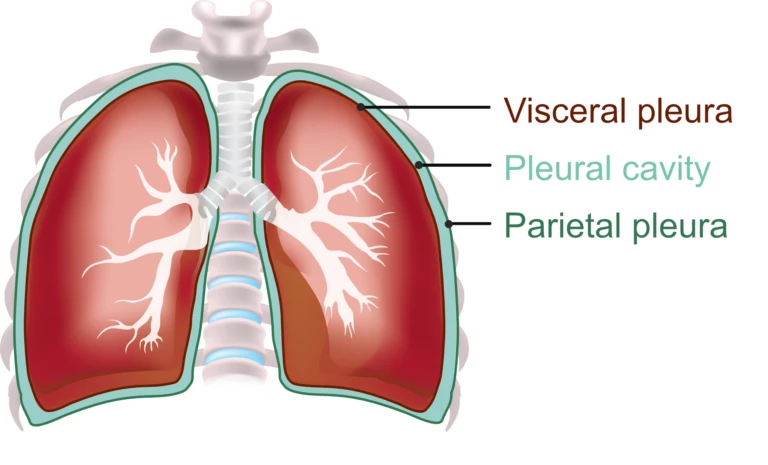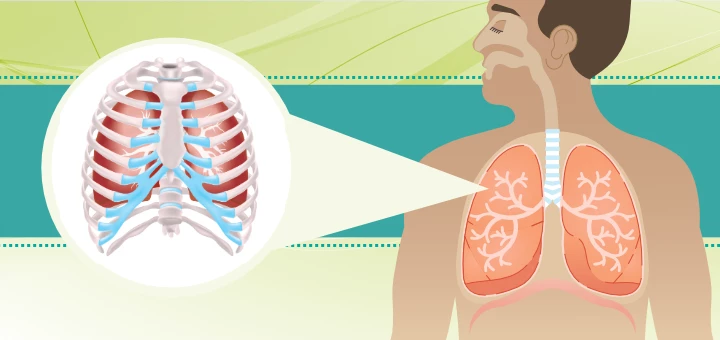Improve Your Vital Lung Capacity with Yoga

The last time I went to visit my mom, she asked me to show her some yoga moves because she wasn’t feeling too well. Once we got down to the floor, I asked her to take a few full, deep breaths. She could barely inhale for two seconds and exhale for two seconds. This immediately sent alarm bells through my brain, since I’ve never seen anybody breathe in such a shallow way. It felt very, very wrong. My mom passed away three months later. This was ten years ago.
The connection between vital lung capacity and mortality has been known for some time now. It was first described scientifically by researchers in the Framingham Heart Study, which has been ongoing since 1948 and is now considered one of the longest, most important epidemiological studies in medical history. The researchers have made many discoveries over the years regarding risk factors for cardiovascular diseases.
Vital Lung Capacity and Your Health
In 1983 they published a research paper based on 20 years of biannual follow-up of 5209 subjects, that placed vital lung capacity at the top of those risk factors. (1) Vital lung capacity is usually determined by measuring the amount of air that can be forcibly exhaled from your lungs after taking the deepest breath possible. This is called forced vital capacity (FVC).
The researchers wrote: “FVC was strikingly related to the incidence of cardiac failure at all ages and in both sexes. The association persisted even after adjustment for age, cigarette smoking, and hypertension, as well as for other cardiovascular risk factors [height, weight, heart rate, and glucose intolerance]. The strong relationship to the development of cardiac failure indicates that the simple vital capacity is a sensitive indicator of impaired cardiac function. […] Vital capacity appeared to rank high as a predictor among the major risk factors for cardiovascular morbidity as well as for mortality.”(1)
The researchers were not exactly sure why it was happening but had some interesting ideas: “The explanation for the remarkable association between FVC and cardiovascular morbidity and mortality is at present rather speculative. … There is one intriguing correlation that may provide a clue; the strongest correlation observed for FVC is with handgrip strength. This suggests that the FVC may well be a measure of overall vigor and general strength.”(1) Could it be that our vital lung capacity is indeed an indicator of our overall vitality?
Multiple studies have been conducted since then (see resources below for some examples), and most of them came to similar conclusions. By now it is widely accepted that vital lung capacity is a reliable predictor of one’s mortality. The forced vital capacity test puts a number to your vital capacity. It shows how much air you can take into your lungs and then actively expel. The ability of your lungs to do that depends on two key factors: lung compliance and lung elasticity. Let’s look at those more closely.
How Do the Lungs Work?
Our lungs don’t have muscular tissue, so we cannot move them at will. Instead, the lungs expand and shrink because of an intricate interplay between pressure and volume within the lungs themselves, the  pleural cavity that separates the lungs from the ribcage, and the atmospheric pressure around you. The outer surface of the lungs (visceral pleura) clings to the inner surface of the ribcage (parietal pleura) with a pleural cavity in between. Your ribcage expands on the inhalation and pulls on the lungs, which forces them to expand. This is called lung compliancy, the ability of your lungs to be stretched out following the movement of the ribcage.
pleural cavity that separates the lungs from the ribcage, and the atmospheric pressure around you. The outer surface of the lungs (visceral pleura) clings to the inner surface of the ribcage (parietal pleura) with a pleural cavity in between. Your ribcage expands on the inhalation and pulls on the lungs, which forces them to expand. This is called lung compliancy, the ability of your lungs to be stretched out following the movement of the ribcage.
But your lungs also contain elastic fibers, which make them shrink back. When you reach the end of your inhalation, your lungs pull your thoracic cage inward as they recoil. This is called lung elasticity. The outward pull of the ribcage on inhalation and inward pull of the lungs on exhalation form your breath cycle. Proper lung function depends on the delicate balance between lung compliancy (ability to stretch out) and elasticity (tendency to recoil).
If your lungs lose their compliance (ability to stretch out), taking air in will become very difficult, because your lungs want to shrivel. This happens if the tissue of the lungs becomes very fibrous, like in pulmonary fibrosis. If your lungs lose their elasticity (ability to recoil), exhalation will become very difficult, since the lungs are no longer able to recoil naturally without effort. This happens with some respiratory diseases, like emphysema.
Your lung compliance is also directly linked to the mobility of your ribcage. It is the expansion of your ribcage that pulls on the lungs to make them expand on inhalation. If your ribcage cannot expand properly because of inflammatory arthritis or a sedentary lifestyle in a collapsed posture, your lungs won’t be able to expand properly either and will gradually lose their compliance (ability to stretch out).
How the Aging Process Affects Our Lungs
Unfortunately, the natural aging process is not kind to our lungs either. It affects your lung function in the following ways:
As you get older, the elastic tissue throughout the body deteriorates, which means that your lungs will gradually lose their elasticity and, as a result, their vital capacity.
Your ribcage stiffens with age because your intervertebral disks narrow and stiffen, which changes the articulation between ribs and vertebrae. It is usually accompanied by decreased elasticity of intercostal muscles. All those factors together compromise inspiration and decrease the elastic recoil of expiration. As a result, it becomes harder to take a breath because the muscles of respiration must work harder during inhalations to counteract the stiffness.
If you have a slight forward head tilt and slight kyphosis (rounding of the upper back) now, it tends to exaggerate with age. This can alter the position of both ribs and diaphragm, which leads to decreased efficiency of inspiration.
All muscles in the body gradually lose strength and endurance with age. This applies to muscles of respiration as well (diaphragm, intercostals, and others). This means that the muscles fatigue more easily, especially when they have to work harder (for example, during physical activity). The effect is amplified if there is an underlying lung condition.
As a result, it is expected that the lungs will lose 12 percent of capacity between the age of 30 and 50 and continue a steady decline from there. By age 80 we would usually lose about 30 percent of our lung capacity. It is not all doom and gloom, however. It doesn’t mean that as we get older, we are destined to go through a steady decline in our lung function.

How to Keep Your Lungs Healthy with Yoga
There are specific things we can do in our yoga practice to maintain healthy lung function. To keep a proper balance of compliancy and elasticity of the lungs, we need to exercise both (although, depending on your health condition, one might be more important than the other). We support lung compliance by breathing in fully, expanding the ribcage, and holding the air in. We support lung elasticity by exhaling fully and holding the air out.
In yoga, we work on maintaining and expanding lung compliancy and elasticity by:
Increasing Breath Threshold: We can consistently work on deepening our inhalation and lengthening our exhalation, In both our asana and pranayama practice,
Working with Breath Retention: We can hold our breath in or out, which divides the breath into four different parts: inhale, hold after inhaling, exhale, hold after exhaling. We can work with specific proportional relationships among those four parts and learn to hold our breath for longer periods of time. This is called the science of ratio. (2)
Dealing with Stiffness of the Ribcage: Doing all five directions of spinal movements (forward bends, backbends, side bends, twists, and axial extension postures) helps us maintain spinal mobility and elasticity of the intercostal muscles. Backbends in particular are effective for preventing “chest barreling” and an increase in kyphosis. To get the most out of those positions, we need to move into them and breathe deeply for some time (potentially adding breath ratios for better effect).
Since vital lung capacity is essential to health, it’s worth putting some effort into keeping our lungs healthy and resilient, which, hopefully, can slow down the respiratory decline associated with aging.
Also, read...
Are You Making This Common Stretching Mistake in Yoga?
Dr. Ray Long: How to Enhance Your Breathing Capacity During Yoga
Yoga Anatomy: The Adductor Muscles in Downward Facing Dog Pose
Related courses
Breath as Medicine: Yogic Breathing for Vital Aging
Yoga and Myofascial Release: Releasing Chronic Tension with the Bodymind Ballwork Method
Yoga and Detoxification: Tips for Stimulating Lymphatic Health

Educated as a school teacher, Olga Kabel has been teaching yoga for over 14 years. She completed multiple Yoga Teacher Training Programs but discovered the strongest connection to the Krishnamacharya/ T.K.V. Desikachar lineage. She had studied with Gary Kraftsow and American Viniyoga Institute (2004-2006) and received her Viniyoga Teacher diploma in July 2006, becoming an AVI-certified Yoga Therapist in April 2011. Olga is a founder and managing director of Sequence Wiz— a web-based yoga sequence builder that assists yoga teachers and yoga therapists in creating and organizing yoga practices. It also features simple, informational articles on how to sequence yoga practices for maximum effectiveness. Olga strongly believes in the healing power of this ancient discipline on every level: physical, psychological, and spiritual. She strives to make yoga practices accessible to students of any age, physical ability, and medical history, specializing in helping her students relieve muscle aches and pains, manage stress and anxiety, and develop mental focus.
- Vital capacity as a predictor of cardiovascular disease: The Framingham Study (1983)by W.B. Kannel, M.D., Helen Hubert, Ph.D., and E.A. Lew, A.M., FSA.
- https://sequencewiz.org/2014/07/02/calm-down-before-bed/
- Lung Function May Predict Long Life or Early Death (2000) by Science Daily
- Why Does Lung Function Predict Mortality? Results From the Whitehall II Cohort Study (2010) by Severine Sabia, et al.
- Association of lung function with cardiovascular risk: a cohort study (2018) by Bin Wang, et al.
- Aging and Activity Tolerance Orthotics and Prosthetics in Rehabilitation by Ethan A. Hood, Kevin K. Chui, Michelle M. Lusardi
- Breath: The New Science of a Lost Art by James Nestor
- Respiratory| Compliance and Elasticity (video) by Ninja Nerd Lectures
- Respiratory| Mechanics of Breathing: Pressure Changes (video) by Ninja Nerd Lectures



